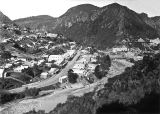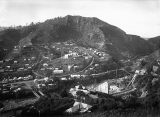KARANGAHAKE the years of the gold 1875 -1935
Some years ago when we were collecting facts about early Karangahake, Mr George Chappell of Waihi, was, to us, a veritable "gold mine". Although he lived to his late 90s, his mind was still vividly clear about the years 1897-1914 when he was Chief Assayer for the Talisman Mine. Having trained at the Thames School of Mines, his first important job was in the Talisman Office, near the Tramway Hotel. It was his home for 17 years as, for security reasons, he was required to sleep above the strongroom, although he had his meals at the Hotel. On returning from World War I, he held a similar position of trust at the National Bank Refinery in Paeroa, followed by many years at the Martha Refinery at Waihi.

Karangahake in its heyday - 1910.
KARANGAHAKE the years of the gold 1875 -1935: Karangahake at its Peak
Mr Chappell handled millions of pounds worth of gold in the days when wages were small. In his younger days, photography, with a glass plate camera, was his chief hobby and we owe him untold gratitude for many old pictures of Karangahake he made available to us, as well as for articles he contributed for the Historical Journal, e.g. the following:
Soon after the turn of the century Karangahake was a very lively town with a population of about 2000. No doubt it was a noisy place, so far as work was concerned, but it had a generous community spirit with ready help for those in need. In this respect, the Miner’s Union played a big part, as did several Friendly Society Lodges (Oddfellows and Druids), contributing assistance in times of accident (frequent) or distress, such as illness due to Miners’ Phthisis.
"As in most mining towns, gambling was prevalent for small odds and indoor entertainment was not lacking in three Halls, often patronised by travelling shows or filled by local performers as Concerts were frequent and the people very music and dance—conscious. The Hanlen family were among the early musicians, and had various pupils. Abe Hanlen built a four—roomed cottage just outside the school ground. He sold it to George Fallon, and another one to Herb Robinson, both of whom were Band Masters, who saw that good use was made of the Band Rotunda on Sunday afternoons, sometimes with brass instruments, and sometimes with strings and flutes.
"As there were so many single men, there were many Boarding Houses. I remember names such as: Jubilee, Collinson, Crown, Lawler, Bidois, Lookout, Brookside, Kemps and Johnsons.
"Sport played a prominent part in the lives of the men. There were some excellent Football Teams, and one year there were 11 Karangahake players in a Thames Valley side. One of our men, George Gillett, was regarded as a rugby marvel, being able to take his place anywhere in a team, which frequently he Captained. He was an All Black in the famous 1905 Reps. Other All Blacks were Douggie McGregor, who went to California in 1918, and Australia in 1919. Scotty McClymont, an International Rugby League player for 10 years, became even more famous as a Selector Coach and Manager, after he left Karangahake. Other outstanding players were: Jack Baggest, Ernie Jury, Tiffy Lang, Dave Dean, W. McLean, Bunting Brothers, Dillimore and Bramble.
"There was also an excellent team of Lady Hockey Players, and I recollect that Karangahake’s Champion Gun Club, won an enormous cup three years in succession. Mr Meachen was President and Fred Dare a crack shot.
"In my day the town was lit by gas generated in Paeroa in 1897 by the Ohinemuri Light and Power Coy, but we were not far from the era of lamps and candles, and still a long way from modern sewage and washing machines. Shops remained open until 8 or 9 p.m. from Monday to Friday and on Saturday until 10 or 11 p.m. while the Hotels plied their trade the full 24 hours, catering for the "shifts" going on and coming off work. Men with their pink candles and crib tins were always coming and going, and people gathered quickly when the dread siren announced an accident.

Karangahake in 1909 with Talisman battery in foreground.
Auckland Museum.
KARANGAHAKE the years of the gold 1875 -1935: Karangahake at its Peak
"A horse—drawn Ambulance was in frequent demand (as was the horse-drawn fire—fighting equipment). At first the nearest doctor was in Paeroa, but for short periods we had Dr Craig in Mackaytown, followed by Dr Cheeseman in Karangahake.
"I had great admiration for the wonderful teams of horses that brought equipment for the mines, and indeed, for the mine horses that pulled heavy loads quartz to the batteries.
"Admittedly our rivers became polluted, but we were fortunate in having an excellent domestic water supply from a reservoir in the upper reaches of the Rahu Creek and piped to the town from the Butlers Track area. At first there was a stand pipe and tap between two houses, but eventually every house had its own supply.
"The hills had a great fascination for me and I spent much of my spare time photographing the amazing scenery. On the social side, I helped with the laying down of the Bowling Greens, Croquet Lawn and the Tennis Courts, on which I later played. They were situated beside the School of Mines, an institution after my own heart. Under Mr Bob McDuff and later Mr Gibson, it raised the standard of education of mining men, helping to equip them for positions of greater responsibility."
